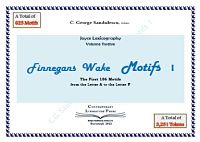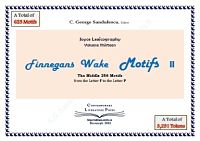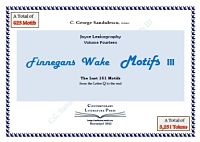Finnegans Wake Motifs I, II and III
edited by C. George Sandulescu.

Vol. 12. Finnegans Wake Motifs I |

Vol. 13. Finnegans Wake Motifs II |

Vol. 14. Finnegans Wake Motifs III |
FW Motifs I (348pp), FW Motifs II (459pp), and FW Motifs III (310pp) is a single topic divided, for convenience, into three distinct volumes, totalling more than 3,000 entries. They are all launched here simultaneously. In addition to other advantages, the procedure gives each and every entry the characteristic of being open-ended. Open-ended lexicography should be the topmost feature of FW Studies for as long as we are — honestly and sincerely — trying to work out what the book is really about. We start from the basic expectation that Joyce's FW is about everything. At a time of controversial globalisation, when no literature is 'national' any more — a single literature of the European Union is, currency-wise, quite inconceivable — FW suddenly leaps, deliberately and voluntarily, into the unique position of being a piece of genuinely European fiction. It is European genetically, having been conceived, and scribbled, in bits and pieces all over the place, Copenhagen included, with Dick Ellmann's biography certifying it. It is European linguistically, with a neat list of 40 languages (Danish excluded!) inextricably tagged to its very Manuscript. And, finally, it is profoundly European in point of subject matter: the Motif is one of the three or four kinds of glue that have been consistently used to fuse it together. That is the reason why glue specialist Clive Hart discusses the Motif glue together with the Structure glue. It is the kind of binding stuff that Roland McHugh has no ways or means to touch in his Annotations: some of the building blocks are there, of course — in meaning only — but in quite another capacity. For what counts most with motifs is their frequency of occurrence; though low frequency never entails lack of amplitude. But we regret that 50 years of Joyce Studies, with Foundations sprinkled here and there, have ignored the major motifs, never treating them as such. Bear in mind please that the fairly systematic study of motifs — by the side of langues et civilisations — provides the safest inroad into the real overall understanding of this complex James Joyce book.
|
(Romanian follows below)
Please click on the link below and choose "Save file" to download the book in .pdf format
Vol. 12. Finnegans Wake Motifs I
FW Motifs I (348pp), FW Motifs II (459pp) și FW Motifs III (310pp) constituie de fapt un singur volum cu peste 1.000 de pagini și mai mult de 3.000 articole de dicționar. Aceasta este, așadar, rațiunea pentru care le lansăm împreună. Împărțirea arbitrară în trei volume are avantajul că fiecare articol, luat în parte, rămâne deschis: cititorul este astfel invitat să ducă mai departe cercetarea deja începută.
Scopul celor trei volume de Motive, ca de altfel al întregii serii Joyce Lexicography, publicate de Contemporary Literature Press, este să descopere — ori măcar să încerce să descopere — ce anume urmărește Joyce să ne transmită prin Finnegans Wake. Pornim de la premisa că Joyce vrea să prezinte întregul univers pământean.
Să nu uităm că, atunci când a scris aceste enigmatice 628 de pagini, Joyce n-a avut nicio o reședință stabilă: cartea aceasta este un jurnal imaginar de călătorie. Dar ea este și un dicționar viu, care include 40 de limbi, înșiruite de însuși autorul ei pe ultima filă de manuscris. Ne mai rămâne doar să adăugăm că Finnegans Wake este în primul rând despre Europa. Motivele sunt tocmai acele elemente care ne îngăduie să ne apropiem cât mai mult de un așa-zis "subiect" al acestei cărți...
Pornind de la Wagner, ideea de leitmotiv a făcut carieră. Printre scriitorii care au folosit-o drept procedeu literar au fost T.S. Eliot și James Joyce; dar să nu uităm nici pe Gertrude Stein, cu al ei dicton a rose is a rose is a rose. Mecanismul este simplu: motivul acționează prin repetare. FW Motifs pornește de la o frecvență minimă de 2 și ajunge până la 55 în unele cazuri. Considerăm că această repetare este importantă pentru felul în care Joyce jonglează cu literele, sunetele, cuvintele, sensurile și ideile: faptul că un motiv poate avea 40, 50, sau chiar 55 de variante, spune foarte multe celui care analizează implicațiile fiecărui motiv în parte, dar și ceea ce au ele în comun. Aceste Motive sunt până la urmă langues et civilisations din toate timpurile și din toate locurile! Tot ele sunt și drumul cel mai sigur către înțelegerea complexității lui Joyce, care, credem noi, rezidă, paradoxal, într-un mănunchi de idei relativ simple.
Lidia Vianu
Pentru a descărca volumele în format PDF vă rugăm să apăsați legăturile de mai jos:
Vol. 12. Finnegans Wake Motifs I
